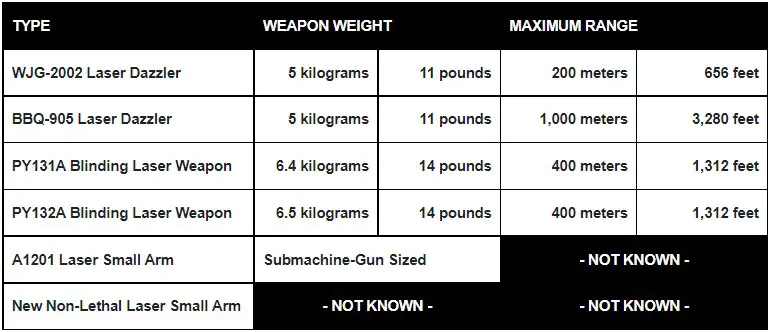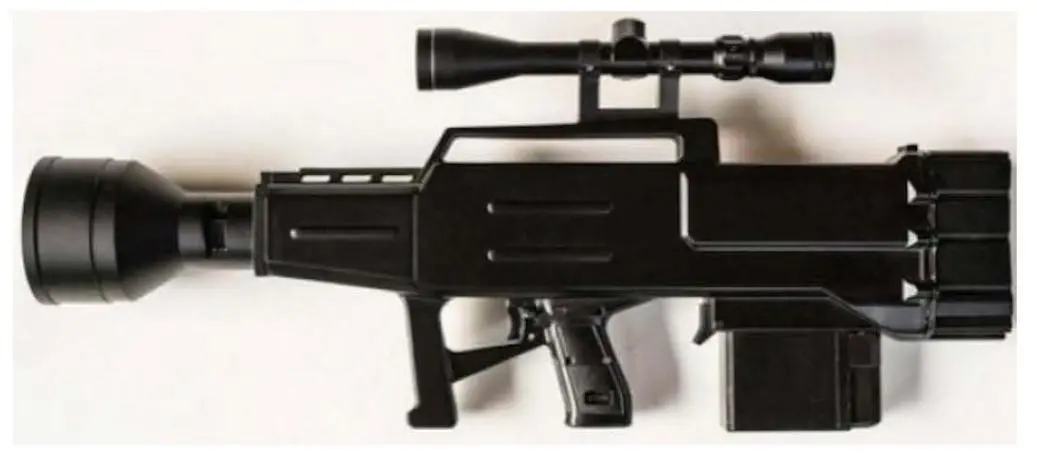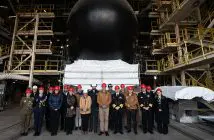A TTPs Research Note.
Written By Chris Flaherty.
INTRODUCTION

This Tactics, Techniques, and Procedures Research Note is intended to look at how China’s military may come to use Battlefield Laser Weapons, and looks at a possible emerging combat doctrine. It is based on recent instances where military forces have used Laser Weapons. It appears, use of the weapons are currently seen as a means of coercion and dissuasion on China’s boarders: these are areas that are China’s periphery regions, where the People’s Liberation Army would prepare for local war, or wars that would occur within a defined area using particular types of weapons with limited goals (Cheng, 2012). Largely aimed at craft, the weapons nevertheless have potential to harm Human eyes. Problematically, pursuing development of a plethora of Laser Electronic Human Optical Blinding and Dazzling Weapons, which also resemble Infantry Small Arms, points to the possible use of these as part of the basic arming of Infantry units. Tactics used in the past, have been where powerful Laser Range-Finders were used-misused, that in the right circumstances caused mass blinding of soldiers on the battlefield. This could serve as a basic shock action in order to achieve dominance; notwithstanding International Laws banning the use of such weapons, derived from a Geneva Convention Ban on weapons that deliberately blind a Human.
HISTORICAL CONTEXT
The technical-historical context for the use of Laser Weapons, is these:
- “do not represent some sort of ‘notional or what if’ threat but already exists in real world Counter-Optical and Vision Disrupting concern for the U.S. military services and for some governmental and law enforcement agencies” (Bunker, 2008).
The development of tactical use based on Counter-Optical and Vision Disrupting has been along a separate line, from the notional use of a Burn-Through type of Laser, and represents a different concept of lethality:
- “a Laser need not kill … in the traditional sense of putting holes in … [a Human target]… with inert matter … or with the direct energy Beam of a High-Energy Laser … [rather a Low-Energy]… Laser … is sufficient to instead target the eyes.” (Lindsay, 1998; Bunker, 2000a)
Since the 1980s, fears as to the use of a Laser to cause blindness as a means to destroy another combatant led eventually to a Geneva Convention Ban.
THE GENEVA CONVENTION BAN
Fears in the 1980s of the use of Blinding Lasers, led to bans being pursued at a governmental level. However, this was not the same situation in the United States domestic policing and security spheres. From around 1999, till 2008 (and continues to be the case), considerable alarm was raised about the development, and proliferation of Laser Pointer Technology. It was concluded the Laser Pointer presented a major threat to military, and law enforcement, namely its ability to cause eye damage, and blindness. Proliferation of Laser technology that could be used as Counter-Optical Tactics Weapons was already identified at the start of the 1980s, when concerns were raised about the threat of Low-Energy Lasers to Human vision on the battlefield (Bacon, 1980; Morrison, 1985; 1987; Anderberg, 1988). By the mid-1990s in the defence sphere a ban on Blinding Lasers was in place. This was the 1995 U.S. Department of Defence policy on Blinding Lasers, that:
- “prohibits the use of Lasers specifically designed to cause permanent blindness of unenhanced vision and supports negotiations prohibiting the use of such weapons.” (U.S. Government, 1995)
By the early 1990s, advocates for a Blinding Laser Ban (Anderberg, 1992), led to it being enacted in International Law as a ratified protocol on 30 July, 1998; this was part of the 1980 U.N. Convention on Conventional Weapons (Geneva Convention, 1980; Bunker, 2000a).
A critical complaint about the Geneva Convention Ban, “[is that it]… does not cover inadvertent Human blindness caused by systems designed to disable sensors.” (Roblin, 2018) The latter situation has occurred, where non-weapons: such as Range-Finders have been used as defacto weapons. For instance, many current In-Service powerful Laser Dazzlers, used to disable opponent Laser Range-Finders and Target Designators, use a Beam power (the Wavelength), that could cause blindness in a Human combatant, such as a vehicle driver, or craft pilot caught in the Beam-Path. The origin of the potential tactic relates to incidents known from the Iran-Iraq War (1980-1988), that suggest over a thousand Iranian soldiers were purposely blinded by Iraqi operated Soviet tank mounted Laser Range-Finders (Bunker, 2008).
BASIC TACTICAL USE
Laser use combines several novel tactical qualities. It hits its target instantaneously. If the Laser components used do not produce a coloured Beam, this is invisible (as its Wavelength is outside the range of Human visibility), and will not emit any sound when fired. Harnessing tactical factors: invisibility, silence, and instantaneous effect could dramatically favour attackers. From the 1990s, the threat was recognized coming from potential criminal misuse of Commercial Laser Pointers, and a further potential for conversion into a military weapon:
- “one of a number of military follow-on technologies to firearms. They will probably be one of the first law enforcement will have to contend with domestically, for both defensive and offensive purposes. Laser Pointers represent harbingers of some of the Small Arms to come based on direct energy.” (Bunker, 1999)
Dubbed the, “Common Laserarm” (Bunker, 1999; 2000), this was a hand-held tubular device with a cable connected to a battery box. Its use was to create Counter-Optical Tactics (Bunker, 2000).
One of the earliest differences identified, with powerful Lasers falling into Class 3B (Medium) and Class 4 (High to Severe Eye Injury) classifications, when compared with Conventional Firearms, was the:
- “effective ranges measured in hundreds and, in some cases thousands, of meters which makes them superior in range to most firearms employed by tactical officers.” (Bunker, 2000)
The trend has continued in Counter Optical Tactics (including the Purposeful Blinding tactical variation), that has seen Laser Pointers (Pens), and Internet purchased Higher-Powered Green Laser Pointers used to attack Riot Police. The same tactic has potential use in the exotic battlefield of Space. A precursor, the Soviets around 1984, developed a Laser Pistol that used a lamp-cartridge loaded pyrotechnic flash, with a blinding force up to a range of 20 meters: 65 feet. It was intended for use by Cosmonauts in hand-to-hand fighting in Space (Zak, 2018).
SMALL ARMS VARIETY OF CHINESE LASER WEAPONS
The Chinese ZM-87 (a North Korean version is also known to have existed), is said to have been the first Personal Laser Gun fielded in the early 1990s (Federation of American Scientists, 1998; Bunker. 2008; Roblin, 2018). The ZM-87 Portable Laser Disturber, was developed by Norinco (China Ordnance Industries Group Corporation Limited). It was first displayed at the International Defense Exhibitions in the Philippines and the United Arab Emirates, in 1995 (Federation of American Scientists, 1998; Roblin, 2018). Around 2018, Laser Small Arms configured to give the appearance of rifles, or submachine-guns, like the Chinese ZKZM-500, made an appearance. Made by the Xian Institute of Optics and Precision Mechanics, in Shaanxi Province (also attributed to the Chengdu Hengan Police Equipment Manufacturing Company), the weapon had a rifle-like appearance with a stub-nose barrel end (Trevithick, 2018; South China Morning Post, 2018; Lin, 2018).
The Chinese ZKZM-500 YouTube video is said to demonstrate its Burn-Through range on a crudely set-up building rooftop target, which is estimated to be a distance of 150 feet: 45.7 meters from the firing-line. However, in the YouTube video the range is stated as some, “several hundred meters … [half a mile]” (South China Morning Post, 2018). News reporting described the weapon as a 15mm calibre, weighing 3 kilograms: 6.5 pounds, about the same weight as the standard Russian AK-47 Assault Rifle, with a range of 800 meters: 2,624 feet (Chen, 2018). It should be noted, statements about this weapon such is its weight, calibre, and capabilities were miss-reported. It appears, the ZKZM-500 falls into a category of an Infrared Spectrum Weapon, and is probably intended primarily as a Counter-Optical Dazzler.
Laser Small Arms designed as Counter-Optics Dazzlers and Blinding Weapons, rely on the, “unique properties of Lasers play … in their effect on the eye.” (Begert, 2008) So far, an entire suite of In-Service Chinese Counter-Optical Dazzlers and Blinding Laser Weapons have been developed over the last three decades. In addition to the ZM-87, and ZKZM-500 (which is pictured below), the rest of the series can be found in the following table:

The only information apparently known about the Chinese ‘New Non-Lethal Laser Small Arm’, relates to its power, and intensity:
- “[it]… uses an eight-kilowatt short-pulse Beam to incapacitate targeted individuals by briefly heating surface of their skin to 500 degrees Celsius, causing intense, paralyzing pain.” (Roblin, 2018)
The physical appearance of the Chinese Laser Small Arms, all strongly resemble Conventional Firearms (Yao, 2015). For instance, the WJG-2002 Laser Dazzler was designed with a strong resemblance to the Chinese Army’s QBZ-95: Standard Bullpup Type 95 Assault Rifle, and likewise the BBQ-905 has a distinct assault rifle appearance. The explanation for this was to give the weapon a certain amount of camouflaging – disguising it in plain sight, so to speak,
- “blend in with standard Infantry weapons recalls the Soviet ROKS flamethrowers, designed to resemble a bolt-action rifle so as not to draw attention, down to having a wooden exterior.” (Roblin, 2018)
It has also been speculated the design is,
- “likely to both make it easier for troops to carry and to make it less likely for enemy forces to quickly isolate an individual carrying the system and focus their fire on them.” (Trevithick, 2018)
► The Chinese ZKZM-500 Laser Rifle. This is said to be the size of a standard AK-47 Assault Rifle. However, the actual weapon’s weight is likely to be much heavier.

Comparatively, the PY131A and PY132A are described as bazooka-like weapons (Roblin, 2018). The main difference is the front of the weapon opens-up to a wide lens. Whereas the WJG-2002, and BBQ-905 have more the appearance of a wide-gauge stubbed barrel end. This feature has given rise to the misnomer description given to the ZKZM-500 that it had a 15mm calibre. The function of the wide lens end to the PY131A and PY132A, and the same fitting is depicted on a photograph of a version of the ZKZM-500 (see above), which is attributed to the Chengdu Hengan Police Equipment Manufacturing Company (Trevithick, 2018), may be a Telescope Laser Beam Expander component.

▲ An illustration of the current variety of Chinese Laser Small Arms Weapons: WJG-2002; PY131A; BBQ-905; and, APY132A (South China Morning Post).
Judging by the YouTube video, the 2018 Chinese ZKZM-500 fired an invisible Beam: making it one operating at the Infrared portion of the spectrum, and invisible to Human eyes. As stated, it was demonstrated burning at a distance cardboard, nylon fabric and a rubber car tire. Human flesh is not burnt. However, an Infrared Beam can destroy a Human eye.
The Chinese WJG-2002 is known to have been designed to pulse a Green Laser Bean three times per second to Dazzle causing dizziness, and blindness (Roblin, 2018). The Green Lasers are regarded as more damaging to eyesight than Red Lasers. It should also be noted that all three: Blue, Green and Red Level Lasers while designed, and intended for Counter-Optics tactics, these all pose a substantial risk to Human eyesight. Problematically, Lasers fall along a spectrum from inflicting short-term effects on Human eyes, to causing catastrophic damage resulting in permanent degraded sight, to blindness. While, primarily designed for Counter-Optics tactical use, many of these potential weapons, are all capable of causing Human eye damage and permanent blindness – and will allow tactics to evolve with the specific aim of doing so.
The fact that these weapons are made to look like Infantry Small Arms tends to suggest that Infantry units will be equipped with these weapons to be used as a means to blind and dazzle opponents. It can be argued that the main purpose of each Infantry unit having a number of soldiers carrying a Laser Weapon is using these for basic unit protection – intended to blind opposing Range-Finders, so the unit cannot be targeted on an increasingly lethal battlefield. However, such a weapon have potentially a dual effect in terms of its Counter-Optics value: it effects electronic and Human eyes (both are types of range sensors) at the same time potentially: able to effect/harm electronically and biologically (as is shown in FIGURE 1).
FIGURE 1: Laser Effect on Electronic and Biologic Sensors

The Chinese Main Battle Tank (the Type 99) are also equipped with roof (top of turret) mounted stabilized day/night sight that also includes a Laser Range-Finder. This is located at the left front of the tank’s turret. It is highly possible, given the previous use of Soviet tank mounted Laser Range-Finders by Iraqi operators used to blind large numbers of opponent soldiers, that these continue to have the same defacto weapon’s role.
Chinese In-Service weapons are made to look like Conventional Firearms, in order to hide these in plain sight, so that within a grouping of soldiers the ones carrying Laserarms cannot be readily identified. When the weapon is used there is a certain degree of shock, and confusion inflicted on an opponent, as a tactical advantage, as they cannot tell ‘where the shot came from’.
COUNTER-OPTICS (PURPOSEFUL BLINDING) TACTICS
The question that needs to be addressed: given China’s military have developed since the 1990s a suite of Laser Blinding and Dazzling Weapons, as apparently Infantry Small Arms, what then is the employment doctrine that may be developing? Something of an answer to this question can be found in a 2020 claim made on a telecasted program, apparently based on reporting from multiple Chinese media outlets; it was claimed:
- “Chinese … soldiers had used Directed Energy Weapons (Laser Weapons) against Indian soldiers during the skirmishes at the Ladakh border.” (Dar, 2020)
The scenario claimed to have occurred, is said to have been where, “Indian soldiers were in control of the top peaks in Ladakh and were impossible to be thwarted using conventional weapons.” (Dar, 2020) The claim made in the TV program was Chinese Infantry were located at the base of the mountain and attacked an Indian position towards the mountain peak, converting this into an ‘oven’ which resulted in the Indian soldiers quickly withdrawing from the dominating position. This case apparently involved a boarder: periphery regions conflict scenario between China and India. Using unconventional-exotic weapons, like a Laser, appears to have been the only option to drive an opponent from a position, leaving that intact for new occupation; at the same time producing a situation where there is no clear military escalation. For instance, taking-away a high-observation position conventionally would either involve a ground assault and hand-to-hand confrontation, artillery or missile bombardment – which would create a massive military escalation, and invite the inevitable greater-force retaliation.
In similar circumstance, as a means of coercion and dissuasion on the boarders: periphery regions of China, use of Laser Weapons by China’s military forces have been seen in the East and South China Seas, “[with]… increasing frequency since at least 2018.” (Cronin, 2020) A similar use of Laser Weapons by China, to that seen in the Indian boarder conflict, is said to achieve:
- “leveraging Lasers and other emerging technologies to expand and police its offshore sphere of influence and keep American and allied naval power at bay.” (Cronin, 2020)
Used as implements of coercion and dissuasion, the use of Electromagnetic Weapons, including Lasers is largely, “against U.S. personnel” (Cronin, 2020; Xuanzun, 2020). Experiences with these weapons use, tend to support the notion these are both aimed at craft, and at Human Optics simultaneously. For instance, in May 2018, the United States announced that Chinese forces operating out of their overseas base in Djibouti had repeatedly used Lasers to interfere with U.S. aircraft landing there (Browne, 2018). In three incidents that involved the use of military-grade Lasers, the attacks left airmen with minor eye injuries. On one level the Laser is aimed at a craft – potentially damaging it electronically, but the target is also the Human, or Humans operating the craft – who are damaged biologically. In a similar incident a year later, in May 2019, suspected Chinese Maritime Militia Vessels used Commercial-Grade Lasers against Australian Navy helicopter pilots operating in the South China Sea. While the craft itself is targeted by the Beam, the Human pilot is also being effected. Lasers as is well known can be dangerous to Human eyes, and while one aspect of an attack is to disable, damage, or destroy a craft’s electronics; that same Beam temporarily blind pilots, cause headaches, and longer term biological damage to Human optical nerves and the retina tissue at the back of the eye.
IN THE CONTEXT OF THE GENEVA CONVENTION BAN
At a State policy level it has been argued that the Party and military bureaucrats, “support the idea of routinizing the use of Lasers against foreign forces traveling through waters near China.” (Cronin, 2020) It has been noted that this support has been telegraphed to outsiders, via Chinese English speaking media, and that this can be interpreted as having a certain level of official support. However, it has also been noted, that the same English language public articles, while intended to send a message to outsiders, have only limited circulation, which suggests that from the Party’s perspective it:
- “considers China’s use of Lasers to be a sensitive topic, and the Party is not yet willing to endorse discussions about their use officially. This fact is important because China’s leadership has not yet tied themselves to the tactic. If they were to decide to stop using Lasers suddenly, it would not be a reversal, and they would not lose face. In short, the use of Lasers may still be negotiable, and the United States should consider implementing a strategy to dissuade China from fully embracing Lasers before the window of opportunity closes.” (Cronin, 2020)
Used as implements of coercion and dissuasion a Laser attack has potential to harm, and as such presents an escalation to lethality where a Human is permanently blinded. It can be anticipated that if Laser Weapon coercion and dissuasion tactics were to be continued to be used these may be used on a massive scale by large numbers of land units, sea and air platforms with the intention to create regional ‘no-go’ zones. The question remains open would more Aggressive Counter Human Optics use of Lasers take place, and what form might this take based on other historical examples. This topic will be looked at next.
AGGRESSIVE COUNTER HUMAN OPTICS USE OF LASERS
Powerful Counter-Optical Laser weapons, rather than used for their intended purpose to disable opposing optical-range equipment, can be used unethically, “[to achieve]… purposeful blinding … [of the opponent]” (Bunker, 1997). Such scenarios are well known based on the fictional Krasnovian Army warfare playbook:
“The Krasnovians are not inhibited by Western ethical constraints. Therefore, in pursuit of an operational edge, they can be expected to employ advanced weaponry which they obtain, such as Counter-Optical Lasers, without moral reservations.” (Bunker, 1997)
The scenario serves to illustrate the notion of a weapons technology shock that begins to reshape the conventional battlefield. The reshape occurs where increasingly powerful current In-Service Laser Weapons are either design for, or used-misused in contravention of the Geneva Convention Ban, and where an opponent is willing to ignore the ‘Laws of War’ (Bunker, 2008). Part of the shock value, the use-misuse of a Laser Weapon represents, is that the wounds it causes to Human victims combine a unique set of medical and psychological problems, which have tactical implications. For instance, a scenario where an Army indiscriminately ‘Lase’ their opponents, the effect on the opponent Army:
- “[they]… would be required to contend with large numbers of ‘blinded’ soldiers who would require medical attention and evacuation, placing further logistical strain on its combat effectiveness.” (Bunker, 1997)
This scenario would recall scenes from the WW1 Western Front with mass blinding of soldiers that occurred with gas attacks, who had to be led-away. Led-back along transport roads into the rear-echelons caused horror among fresh troops moving-up.
► British troops blinded by poison gas during the Battle of Estaires, 1918 (Imperial War Museum).

Among the unique wounding are eye corneal and retinal damage caused by the use of a Low-Energy Laser, and this can include thermal effects, and potential for photochemical changes in the eye (Bunker, 2008; 2008a). Infrared Laser, have been identified as having a greater psychological impact, because damage to the eye can be taking place without initially even knowing that it is happening (Bunker, 2000a; 2008; 2008a). This could create a pervasive fear culture of Lasers,
“[the]… disruptive and destructive effects of Lasers may bring on psychological issues not only for the victims of such incidents but also for those who could become targets.” (Begert, 2008)
Laser Weapons operate on the invisible spectrum for Humans. The ‘invisible threat’ has been recognized as creating a new psychological component to combat dynamics:
“[The] … invisible threat with its especially frightening consequences could affect the willingness of troops to look towards the enemy and use weapons’ sights, and might stimulate conversion reactions of hysterical blindness as an expression of battle fatigue.” (Bunker, 2000a)
“Psychological issues prior to, during, or after a Laser incident may be accompanied by undue stress or performance inhibitions and, thus, have significant impact on mission accomplishment.” (Begert, 2008)
“Once personnel, both military and law enforcement, realize that utilizing magnifying optics or viewing the operational space with the naked eye can pose the risk of being injured or blinded, their mission performance could become degraded.” (Bunker, 2008; 2008a)
It is suggested that Anti-Laser Eye Protection become a key part of a current and future combatant’s battle panoply.
CONCLUSION
Current use of Laser Weapons against craft, and Human pilots by Chinese military forces appears to be as a means of coercion and dissuasion on China’s boarders: its periphery regions. This is where the Chinese military play a type of local war within a defined area such as the border with India, or the East and South China Seas using a particular type of weapon with limited goals to establish regional ‘no-go’ zones for foreign militaries.
Presumably banned by the Geneva Convention, there nevertheless have been continued development by the Chinese military and by other countries as the weapons technology proliferates: a North Korean version of the Chinese Laser Small Arm Weapon is known, of a problematic class of weapons that could be specifically meant for use in Counter-Optics (Purposeful Blinding) Tactics. Such a weapon used by Infantry against opposing soldiers falls into a tactic, which began its genesis in the 1980s, when misuse of Commercial Lasers began, and which remains a pervasive threat to this day by an opponent who decides not to abide by International Law, and is willing to commit war crimes to win. In the past, powerful Laser Range-Finders were used-misused, and in the right circumstances created the mass blinding of soldiers on the battlefield. The ongoing threat posed by a dual-use weapon that potentially harms both electronic and Human eyes, could be easily used as a battlefield tactic intended to serve as a basic shock action, used to achieve dominance; notwithstanding the Geneva Convention Ban.
REFERENCES
- Anderberg, B. Wolbarsht, M.L. 1992 Laser Weapons: The Dawn of a New Military Age. New York: Plenum Press.
- Anderberg, B. 1988 The Low-Energy Laser Aimed at the Eye as a Potential Anti-Personnel Weapon. The RUSI Journal. Volume 133. Number 1 (Spring).
- Bacon, D.P. 1980 Battlefield Lasers: A New Problem with an Old Cure. Military Review (October).
- Begert, M. Campbell, L. Heal, S. 2008 Disruptive and Destructive Effects of Laser Illuminations. FBI Law Enforcement Bulletin. Volume 77. Number 4 (April).
- Browne, R. 2018 Chinese Lasers Injure US Military Pilots in Africa, Pentagon Says. CNN (4 May).
- Bunker, J. 2008 Terrorists and Laser Weapons: An Emerging Threat. Studies in Conflict & Terrorism. Volume 31. Number 5. Routledge.
- Bunker, R.J. 2000 Criminals and Laserarms: Counter-Optical Tactics. The Tactical Edge. Volume 18. Number 4 (Fall).
- Bunker, R.J. Lindsay, D. 2008a Laser Weapons. FBI Law Enforcement Bulletin. Volume 77. Number 4 (April).
- Bunker, R.J. Lindsay, D. 2000a The Laser Threat to California Airborne Law Enforcement. The Journal of California Law Enforcement. Volume 34. Number 2.
- Bunker, R.J. 1999 Criminals and Laser Pointers: Tactical Concerns Over Emergent Laserarms. The Tactical Edge. Volume 17. Number 2 (Spring).
- Bunker, R.J. 1997 Counter-Optical Lasers and OPFOR. Red Trust Star. Publication Volume 30. Number 1 (January).
- Chen, S. 2018 China Brings Star Wars to Life with ‘Laser AK-47’ that Can Set Fire to Targets a Kilometre Away. South China Morning Post (1 July).
- Cheng, D. 2012 China’s Military Role in Space. Strategic Studies Quarterly (Spring).
- Cronin, P.M. Neuhard, R.D. 2020 Countering China’s Laser Offensive. The Diplomat (2 April).
- Dar, Y. 2020 Chinese PLA Troops Used ‘Laser Weapons’ Against Indian Soldiers In Ladakh – Chinese Expert: WATCH. The Eur Asian Times (17 November).
- Federation of American Scientists. 1998 Anti-Personnel Laser Weapons FAS Website (11 November).
- Geneva Convention. 1980 [-1995] Practice Relating to Rule 86. Blinding Laser Weapons: Protocol IV to the Convention on Certain Conventional Weapons.
- Global Security. 2018 Chinese Blinding Lasers. Global Security.org Website.
- Imperial War Museum. British Troops Blinded by Poison Gas during the Battle of Estaires, 1918. Photograph Q11586 (Collection Number 1900-22).
- Lin, J. Singer. P.W. 2018 China’s Destructive Laser Rifle has a Half-Mile Range. Popular Science Website (5 July).
- Lindsay, D. Bunker, R.J. 1998 The Laser Threat to Airborne Law Enforcement: Part I. Air Beat. Volume 27. Number 7 (November-December).
- Morrison, D.C. 1987 When Eyes Become the Targets. National Journal (4 March).
- Morrison, D.C. 1985 Laser Weapons Come Down to Earth: Their Targets Electronic and Human Eyes. High Technology (May).
- Roblin, S. 2018 China’s Laser Guns: Everything You Always Wanted to Know About Them. The National Interest Website (12 May).
- South China Morning Post [Center for the National Interest; Global Security]. China’s Latest Blinding Laser Weapons. Illustration.
- South China Morning Post. 2018 Chinese ‘Star Wars’ Laser Gun Appears to Set Fire to Objects at a Distance. YouTube Channel.
- Trevithick, J. 2018 No, China Hasn’t Built A Laser Assault Rifle That Can ‘Carbonize’ People. The Drive: The War Zone Website (July 3).
- UAVDACH, 2020 [-2018] China in Race for C-UAS Tech and Laser Weapons. UAVDACH Website.
- U.S. Government. Office of the Assistant Secretary of Defense. 1995 DOD Announces Policy on Blinding Lasers. Public Affairs News Release (1 September).
- Xuanzun, L. 2020 US Intrusions in S.China Sea can be Stopped by Electromagnetic Weapons: Experts. Global Times (17 March).
- Yao, J. (Editor) 2015 In Pics: China’s Blinding Laser Weapons. China Military Online Website (12 September).
- Zak, A. 2018 The Soviet Laser Space Pistol, Revealed. Popular Mechanics Website (14 June).
AUTHOR
Chris Flaherty is a Space & Defense Tech and Security News Regular Contributor. He was the co-primary author, along with Robert J. Bunker of the book – Body Cavity Bombers: The New Martyrs (iUniverse, 2013). Two essays of his, from 2003 and 2010 were reprinted in the Terrorism Research Center’s book – Fifth Dimensional Operations (iUniverse, 2014). He contributed a book chapter – The Role of CCTV in Terrorist TTPs, edited by Dave Dilegge, Robert J. Bunker, John P. Sullivan, and Alma Keshavarz, the book – Blood and Concrete: 21st Century Conflict in Urban Centers and Megacities, a Small Wars Journal anthology, published on behalf of the Small Wars Foundation with Xlibris (2019).




